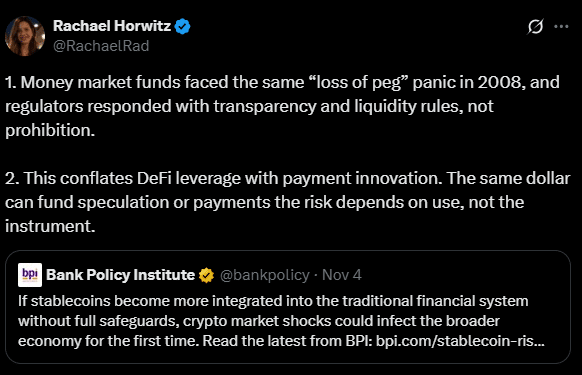The Bank Policy Institute warns that stablecoin rewards could lead to liquidation cascades and market contagion, especially through unregulated DeFi lending loops. This stems from recent events like the October 10th crash involving USDe depegging, causing $20 billion in liquidations, highlighting risks without insurance or proper oversight.
-
Bank Policy Institute highlights stablecoin depegging risks, linking them to broader financial market spills.
-
Leveraged DeFi strategies for stablecoin yields amplify liquidation dangers in unregulated environments.
-
Stablecoin market has grown to over $300 billion in capitalization, with transactions surpassing $1 trillion, showing rapid adoption post-regulatory developments.
Discover Bank Policy Institute stablecoin warnings and crypto community pushback. Learn risks of rewards programs and DeFi integration for informed decisions. Stay ahead in crypto finance today.
What are the Bank Policy Institute’s stablecoin warnings?
Bank Policy Institute stablecoin warnings focus on the potential for crypto market shocks to disrupt traditional finance through depegging events and leveraged yield strategies. The group emphasizes that incidents like the October 10th crash, triggered by USDe’s depegging, resulted in $20 billion in liquidations, underscoring the need for regulatory safeguards. Without insurance or oversight, these risks could accelerate as stablecoins integrate further with mainstream markets.
How do stablecoin rewards contribute to these risks?
The Bank Policy Institute argues that offering rewards on stablecoins via DeFi platforms encourages risky leveraged lending loops, where depositors seek higher yields without FDIC-like protections. This setup heightens vulnerability to depegs, potentially causing rapid liquidations and contagion. For instance, a recent depegging event tied to Stream Finance led to a $93 million loss for one fund, illustrating the dangers when major stablecoins are involved. Experts from the institute note that current laws, including the GENIUS Act, fail to address these specific vulnerabilities, leaving the market exposed to amplified shocks.


Source: X
Frequently Asked Questions
What triggered the Bank Policy Institute’s latest stablecoin warnings?
The warnings were spurred by the October 10th market crash from USDe’s depegging, which unleashed $20 billion in liquidations and exposed flaws in unregulated stablecoin yields. The institute stresses that without reforms, similar events could ripple into traditional finance, affecting broader stability.
Why does the crypto community criticize the Bank Policy Institute’s stance on stablecoins?
The crypto community views the Bank Policy Institute’s position as overly cautious and self-serving, accusing it of framing DeFi as inherently risky to protect banking interests. Advocates argue for enhanced transparency in DeFi rather than bans on stablecoin rewards, pointing to the sector’s $300 billion market cap as evidence of legitimate growth.
Key Takeaways
- Heightened Depegging Risks: Bank Policy Institute stablecoin warnings highlight how events like the USDe incident can cause massive liquidations, potentially spilling over to traditional markets without regulatory intervention.
- Leveraged DeFi Dangers: Rewards programs encourage uninsured yield farming, amplifying vulnerabilities as seen in the $93 million Stream Finance loss, underscoring the need for better oversight.
- Industry Pushback: Crypto leaders like Paradigm’s Alexander Grieve label the warnings narrow-minded, advocating for innovation-friendly regulations instead of outright restrictions on stablecoin growth.
Crypto community reactions
The crypto sector has pushed back strongly against the Bank Policy Institute’s stablecoin warnings, viewing them as an attempt to stifle competition rather than address genuine risks. While acknowledging hazards in leveraged DeFi plays, many in the community argue that banning rewards overlooks the benefits of stablecoin adoption. For example, the surge in stablecoin usage, with over $1 trillion in transactions, demonstrates organic demand decoupled from volatile crypto trends.


Source: X
Alexander Grieve, Vice President of Government Affairs at Paradigm, encapsulated this sentiment by describing the institute’s views as “pretty bad-faith and narrow-minded characterizations.” He further stated, “DeFi = bad, so stablecoins = bad. The Bank Policy Institute seems to have taken the ‘if you can’t beat them, destroy them’ approach.” This reflects broader frustration that the warnings prioritize banking stability over fostering innovation.
Banks vs. builders
The tension between traditional banks and crypto innovators is evident in the Bank Policy Institute’s ongoing efforts to influence legislation. After unsuccessful amendments to the GENIUS Act, the group is now focusing on the CLARITY Act to embed protections for established financial players. Despite these challenges, the stablecoin ecosystem continues to thrive, with its market capitalization exceeding $300 billion and transaction volumes topping $1 trillion.
Data from a16z crypto illustrates this resilience, showing stablecoins decoupling from broader crypto volatility following the GENIUS Act’s passage. This growth signals widespread adoption across payments, remittances, and DeFi applications, even as regulators debate the balance between innovation and risk management. Industry observers, including those from authoritative sources like the Bank Policy Institute reports and Paradigm analyses, emphasize the importance of tailored regulations that promote transparency without halting progress.


Source: a16z crypto
The Bank Policy Institute maintains that stablecoin rewards pose a direct threat by drawing depositors away from insured bank accounts, potentially destabilizing the financial system. However, proponents counter that such yields democratize access to returns previously exclusive to institutional investors. As the debate unfolds, the focus remains on crafting policies that mitigate risks like liquidation cascades while supporting the stablecoin sector’s expansion.
Conclusion
In summary, the Bank Policy Institute stablecoin warnings underscore critical vulnerabilities in DeFi yield mechanisms and depegging scenarios, drawing from events like the USDe crash and Stream Finance losses. While the crypto community pushes for transparency over bans, the stablecoin market’s robust growth to $300 billion signals enduring potential. Looking ahead, balanced regulations could bridge banking concerns with innovative builders, ensuring stablecoins contribute safely to global finance.
